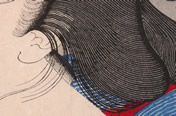
All the prints illustrated on this site are colour prints from woodblocks. Alongside the usual colour-printing, costly printing effects were also used on the best impressions of commercial prints produced in the late Edo and Meiji periods. These were usually printed on thicker ‘presentation paper’ (hôsho), which facilitated special printing effects. Yoshitoshi’s prints were produced when the skills of carvers and printers had reached their zenith. Most of the prints shown here include special printing effects.
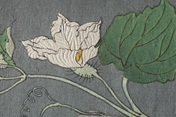
Karazuri (‘empty printing’)
This effect of printing without ink to emboss the paper involved the participation of the carver as well as the printer. A pattern was carved into a separate block. The damp paper would then be pressed into the recesses of the carved block with the edge of the baren, or a piece of ivory or bone. The technique was often used to depict white-on-white patterns or forms, such as the outline of white feathers, or the petals of white flowers, as in this example.
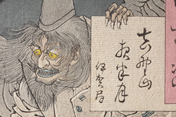
Nunomezuri (‘textile printing’)
For this related embossing technique a textured fabric or gauze was glued onto a specially cut block. The pattern was then burnished into the paper in the same manner as karazuri, so that the texture of the textile was reproduced as a specific part of the print. The effect was often used to depict the texture of areas of clothing or scrolls of paper, or for creating a textured pattern on title cartouches. This example shows a cartouche from the series One Hundred Aspects of the Moon.
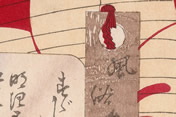
Itame mokuhan (‘imitation woodgrain’)
Another sort of texture was depicted to imitate the effect of woodgrain. A densely grained woodblock was soaked in water to open up the grain, and then inked to print a woodgrain pattern. This technique was often used to depict the grained surface of a piece of woodwork in the image, but it was also used to create patterns on cartouches. This example shows a cartouche from the series Thirty-two Aspects of Customs and Manners.
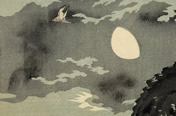
Atenashi bokashi (‘shading without definition’)
Varying the amount of ink across a single block to create a graduated range of tone was known as bokashi (graduated shading); it was often used for skies in landscapes. Atenashi bokashi (‘shading without definition’) was a further refinement, which involved mixing water and pigment on the surface of the block with a brush before printing. The painterly effect varies from impression to impression. In this example it was used to create the smoky clouds around the moon and bird.
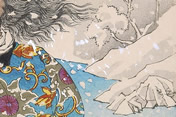
Spattered gofun
Other elements could be added after the printing from blocks was finished. A frequent device was to spatter a white pigment called gofun (calcium carbonate powder obtained by heating and pulverizing the shells of oysters and clams). It was splashed or flicked with a brush onto the printed surface to depict snow or water spray. In this example, some of the snowflakes were depicted by carving holes in the colour blocks, others have been added after printing by spattering gofun.
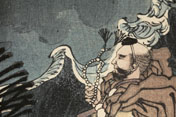
Kirazuri (‘mica printing’)
The silicate mineral mica (kira) was used in various ways on prints to give sparkle. Kirazuri usually involved sprinking fine flakes of mica onto the wet surface of the print, which had been prepared by printing or brushing an area of egg-white or rice paste to make the flakes stick. The sparkling effect is often seen at the top of dark skies in landscape prints. In this example mica was used to create the sparkle on the black waves of the sea around the figure of Benkei.
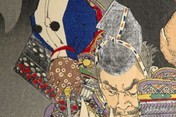
Tsuyazumi (gloss black)
Gloss black was achieved by a technique known as tsuyazumi (literally ‘shiny sumi’), which involved printing two dense layers of black (sumi), using the best available pigment with an extra addition of nikawa (animal glue). After printing, the surface of the black was burnished with a piece of ivory or tooth until it reflected the light. This technique was used for shiny black elements such as hair, lacquer or silk. In this example it was used for the hat and parts of the armour.




